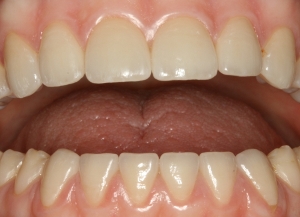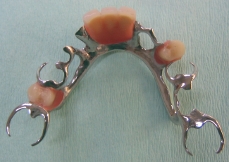Dental prosthetics
Dental prosthetics (manufacture of artificial teeth) is performed when teeth are missing or treatment with fillings is no longer sufficient to restore chewing, aesthetics and, certainly, clear pronunciation of sounds (phonetics) acceptable to the patient. Dentures are manufactured from alloys of noble and base metals, various types of ceramics (porcelain), medical plastic.
Prosthetics is a final stage in dental treatment performed after surgical, periodontological, therapeutic or orthodontic treatment ensuring the stability and longevity of the results of the treatment performed. It is one of the most complicated areas in dentistry requiring a detailed preparatory treatment: planning of other professionals’ work, careful selection of teeth for prosthetics and most importantly a far-sighted forecast – how long will it function?
 |
|
|
|
Dental prosthetics in olden days... |
|
Dental prosthetics today |
Types of Dentures
Dentures are selected individually for each patient, depending on the current condition of the mouth, wishes and possibilities. Two major groups of dentures are distinguished based on whether dentures are taken out from the mouth or not:
- Fixed dentures (laminates, inlays, onlays, crowns, bridge dentures);
- Removable dentures (dentures with metal framework (sometimes also called “bugels”) and veneers).
Removable dentures have to be constantly taken out from the mouth in order to clean food from them. They are most difficult to get used to due to a larger size, lack of stability in the mouth, a distinct feeling of a foreign body, increased secretion of saliva, likely nausea and disturbed pronunciation of sounds. It is difficult to chew food with removable dentures because they press gums. These dentures are the most inconvenient, yet they are manufactured faster and cheaper.
Fixed dentures are cemented on teeth with special cement. Patients do not feel any discomfort and inconveniences differently from removable dentures because there is no need to take them out. Their manufacturing takes longer and is more complicated; therefore, they are more expensive.
The material which will be used for manufacturing these dentures depends on the type of denture, the desired aesthetic result and financial possibilities.
Temporary crowns (used until permanent crowns are manufactured) are manufactured from medical plastic, removable dentures (full, partial veneers and dentures with metal framework).
Major advantages of this material:
- Aesthetic enough;
- Easy to repair;
- Economical.
Disadvantages:
- Lack of firmness, i.e. it breaks, wears off faster than own teeth;
- Change, i.e. change in colour, accumulates plague, bad odours occur faster;
- Irritation, i.e. may cause gingival inflammation or even allergy.
|
|
Individual crowns and bridge dentures can be manufactured from pure metal. Alloys of noble metals (gold, platinum, palladium) or base metals (chromium and cobalt, chromium and nickel, titanium) can be used for this purpose. All-metal dentures have been seldom manufactured recently because they do not look good.
Yet they have several advantages:
- The tooth is little polished;
- The denture is the firmest and the most long-lasting;
- The denture is more economical than porcelain-fused-to-metal dentures.
Normally, porcelain-fused-to-metal crowns or bridge dentures are used. Ceramics (porcelain) is “baked” on a cast metal frame (alloys of noble and base metals can be used) in a special furnace. Dentures manufactured in this way are aesthetical and firm enough.
Disadvantages:
- cracking – ceramic finish may fracture;
- price – more expensive.
Pure ceramics is used for manufacturing crowns, inlays, onlays, laminates. All-ceramic crowns can be used for both incisors and lateral teeth.
Advantages:
- The highest degree of aesthetics obtained;
- Great compatibility with natural teeth;
- Very strong adherence to dental tissues by using special cements.
Disadvantages:
- Occasional cracks of ceramics;
- Restorations are most expensive.
Pure ceramics is used for manufacturing crowns, inlays, onlays, laminates. All-ceramic crowns can be used for both incisors and lateral teeth.
Advantages:
- The highest degree of aesthetics obtained;
- Great compatibility with natural teeth;
- Very strong adherence to dental tissues by using special cements.
Disadvantages:
- Occasional cracks of ceramics;
- Restorations are most expensive.
Fixed dentures
Dental laminates
Where only the front surface is affected, teeth may be restored by means of laminates (veneers). They are thin all-ceramic shells which are bonded on the front surface of teeth by means of special cements. It is a very aesthetical and minimally invasive method of treatment. As all ceramic dentures, laminates must be used properly because they may fracture or unglue.
 |
|
 |
| Before treatment |
|
After the use of laminates |
2.jpg) |
|
.jpg) |
Dental inlays and onlays
Where much of dental tissue is lost due to decay or other causes, it may be restored by means of large fillings. It is a fast and cheap method. However, a higher-quality and longer-lasting solution is the use of micro dentures, i.e. inlays and onlays. Inlays and onlays are firm fillings made of alloys of ceramics or gold in the laboratories manufacturing dentures.
 |
|
|
Dental crowns and bridge dentures
Where much of dental tissue is lost (most frequently after traumas or treatment of root canals), it is recommended to restore such a tooth by means of a crown denture. It restores the anatomical shape, function, aesthetics of the entire tooth and the risk of tooth breaking is reduced.
 |
 |
Implantation is a type of dental prosthetics where the entire missing tooth/teeth is/are restored. Both roots and crowns are restored. That is, the tooth or all teeth are restored by means of implants when they are missing and other types of prostheses cannot be used.Such crowns are usually manufactured in the area of incisors.
Where one or several teeth are completely lost, the defect may be restored by implants or dentures with metal framework. Where a decision is made to use a denture with metal framework, crowns are placed on adjacent teeth, and the gap is filled with an intermediate part performing the function of the lost teeth which is attached to the crowns.
_tiltinis_protezas.jpg) |
Removable dentures
Veneers
Where all teeth are missing or merely several teeth remain, they can be restored by means of implants (dentures will be non-removable) or full (in cases when all teeth are missing) and partial removable veneers (in cases when several teeth remain). When manufacturing veneers, plastic teeth are set into a plastic base imitating gums. Dentures are placed on gums. Where all teeth have been lost, dentures attach to the mucosa merely due to the suction effect. Upper dental veneers adhere much better that the lower ones. The suction effect may be improved by special glue for removable dentures sold in pharmacies but it has to be constantly applied. Where several teeth are present, veneers are attached to them by means of metal clasps.Advantages of veneer dentures (manufactured from conventional (hard) plastic):
- Fast fabrication;
- Easy placement, i.e. all teeth may be missing in the mouth;
- Easy repairs, i.e. it is easy to repair, to add prosthetic teeth which were lost later into the same denture;
- Easy hygiene (dentures need to be taken out of the mouth for cleaning),
- Low price.
Disadvantages:
- Movement, i.e. when chewing, dentures move; the lower veneer usually adheres rather badly;
- Bad aesthetics, i.e. metal clasps are visible; in the long run plastic becomes porous, tends to accumulate plaque faster, changes colour;
- Bad feeling of temperature and taste due to plastic covering palate and gums;
- Effectiveness of chewing is merely approximately 50 per cent compared to fixed dentures;
- Faster bone recession.
Removable dentures can be manufactured from elastic plastics. In this case non-aesthetical metal clasps can be avoided. Patients often say that such dentures are more comfortable than the ones made of hard plastics. However, “soft veneers” have several major disadvantages which determine their low popularity. First, they are much more expensive than conventional plastic dentures. Their repairs are more complicated: to place additional prosthetic teeth, clasps, re-layer the internal surface in order to compensate constant rearrangement of the bone under the denture. A paradox is that the major disadvantage is the fact that “soft veneers” contribute more to the bone recession than the hard ones. The hardness of human jaw bones is different in different areas, thus, their resistance to pressure is also different. For instance, the palate is very resistant to pressure and recedes slower under removable dentures than other areas of the upper jaw bone. Removable dentures made of conventional plastic due to their hardness tend to transfer the load of chewing to the areas of harder bone. Whereas, “soft veneers” redistribute the pressure caused by chewing less and the jaw bone recedes faster. The more jaw bones recede, the worse removable dentures adhere.
Dentures with metal framework
Generally, dentures with metal framework are considered to be the best type of dentures out of the worst (removable). They resemble of partial veneers but they have a smaller metal framework instead of a massive plastic base. Therefore, dentures with metal framework are firmer, occupy less space, better adhere in the mouth, jaw bones under them recede less and they are more comfortable than veneers.
Dentures with metal framework are attached to teeth by means of clasps or fixed by special attachments. Dentures with metal framework and attachments are more stable in the mouth and much more aesthetic because clasps are invisible. However, in this case crowns have to be placed on at least several supporting teeth at each attachment. Therefore, usually it is not the method of treatment which spares the remaining teeth.
 |
 |
The same disadvantages are characteristic of dentures with metal framework as of all other removable dentures: longer period of adaptation, a distinct feeling of a foreign body, increased secretion of saliva, possible nausea and disturbed pronunciation of sounds, a greater tendency of food to accumulate in the mouth. Besides, fabrication of this type of dentures is much more complicated. Frameworks cost much more than veneers. Therefore, upon advances in dental implantology, dentures with metal frameworks as all removable dentures in general are manufactured increasingly less often.
specialists Contacts Doctor's appointment






